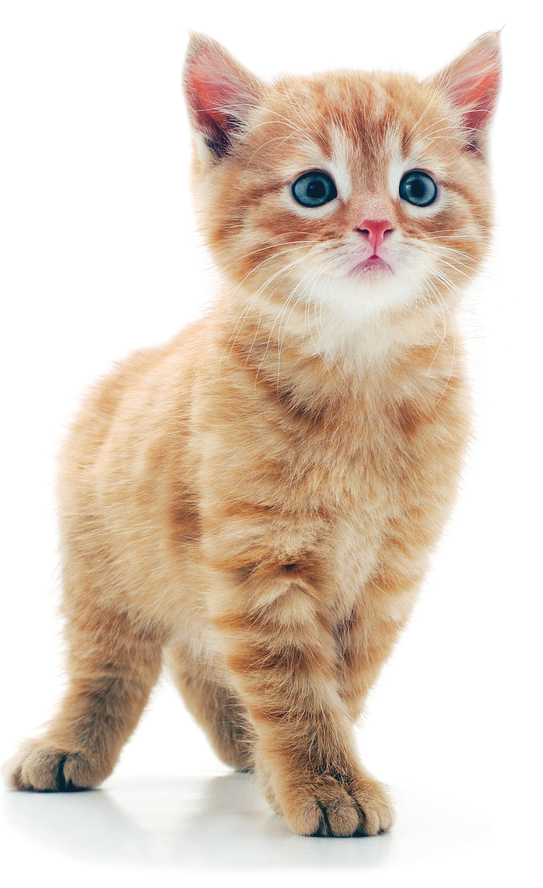You took in a pregnant stray cat and have been fostering her and her kittens. The kittens are a few weeks old now and starting to walk, but one of them struggles, stumbles, and falls a lot. What is going on?
Damaged Cerebellum
The kitten in this scenario likely has cerebellar hypoplasia, or an underdeveloped cerebellum. The cerebellum is the part of the brain responsible for balance, coordination, and fine motor skills, and becomes fully developed a few weeks after the kitten is born. Any damage during this critical period can result in permanent deficits.
In most cases, that damage is in response to panleukopenia, sometimes referred to as feline distemper. If a kitten is exposed to this virus while in utero or after being born, the virus attacks the rapidly dividing cells of the cerebellum and destroys the growing nerves. The extent of the damage depends on the age of the kitten and the developmental stage of the brain.
Entire litters can be affected, or it may just be one or two kittens. Some kittens may have more severe signs than others.
Other less common causes include head trauma, malnourishment while in utero, and toxoplasmosis infection.
Because cerebellar hypoplasia is a developmental disorder, there is no treatment or cure.
Common Signs
Kittens with cerebellar hypoplasia are abnormal right from birth, but their balance deficits are often not noticed until the kitten is 4 or 5 weeks old and littermates are becoming more skilled at walking and playing. These kittens are clumsy, tending to wobble and weave when walking, and may fall over frequently. Their movements are jerky, with high-stepping strides and a tendency to sway. The kitten may keep her feet in a wide stance for better balance. Some learn to lean on walls for added stability when on the move.
When stationary and at rest, these cats look normal. Some will have “intention tremors,” and start to twitch and wobble when they decide on an action and start to pursue it. This can include anything from walking and running to leaning over to eat.
The cat will likely become more proficient at navigating her environment as she masters her body and where everything is located, but she will never move normally. Some cats have only mild signs, while others may be more severe. It is a non-progressive condition, so the cat will not worsen over time.
There is no test for cerebellar hypoplasia. In some cases, magnetic resonance imagery (MRI) may show that the cerebellum is smaller than normal, but a diagnosis is usually made by watching the kitten move and evaluating risk for panleukopenia exposure during development. If a kitten has had a known traumatic head injury, the veterinarian will take that into consideration as well.
Vaccination
You may have recognized panleukopenia as one of the diseases covered in your cat’s routine vaccinations—this is the “P” in FVRCP and RCP, and the disease colloquially referred to as “feline distemper” (see “Feline Panleukopenia,” May 2020, available at catwatchnewsletter.com). If a queen has been kept up to date on this vaccine, she will have antibodies to panleukopenia that protect her and that she can pass on to her kittens so they are protected both before and after birth (then once the kittens are old enough that their maternal immunity is starting to wear off, they can receive vaccines to stimulate the production of their own antibodies). Kittens born to vaccinated mothers are usually safe from cerebellar hypoplasia.
If a pregnant queen either has not been vaccinated or has an unknown vaccination history, a veterinarian should be consulted to evaluate her case. The modified live version of the panleukopenia vaccine should never be given to pregnant queens or to kittens under 4 weeks old, as these individuals have a compromised immune system and may develop the disease in response to this vaccine. The American Association of Feline Practitioners recommends that the inactivated version of the vaccine be given if it is necessary to vaccinate a pregnant queen. In most cases, a wait-and-see approach is chosen, and the mother and kittens can be vaccinated when the kittens are old enough.
Living with Cerebellar Hypoplasia
Cerebellar hypoplasia is not painful, and it is not contagious. For affected cats and kittens, living life on a tilt-a-whirl is normal. Kittens with cerebellar hypoplasia will go through the same growth and learning stages as normal kittens, experimenting first with walking and then with running, jumping, climbing, and play-fighting. They will just be clumsier!
Use food and water bowls with wide bases that are difficult to spill, as these cats will bump into the bowls. Raised bowls may make eating and drinking easier for some cats and can make it easier to prevent spills. A cat with cerebellar hypoplasia can still use a litterbox, but may need a larger box to make a better target. A lower lip on the litterbox may help.
Cats with cerebellar hypoplasia may be more prone to minor injuries due to falls or bumping into things. These cats should be kept indoors or on a leash at all times to keep them safe from the dangers of the outside world, and in cats with severe cases, it may be necessary to prevent access to stairs and to discourage climbing on furniture.
Affected cats can live with other cats and animals, but owners should be mindful when introducing them. Monitor other pets in the household closely to be sure that they will not attack or harm the new cat because she moves strangely. Some pets will adjust quickly, while others may never be trustworthy. Make sure that the cerebellar hypoplasia kitty can eat her meals in peace.
These cats often live long, healthy lives, and their wobbling can be quite adorable. It’s just important to help them stay safe.




